Address any questions or comments regarding this newsletter to the individual authors listed after each article or to its editors, Nathan Johanning, 618-939-3434, njohann@illinois.edu or Bronwyn Aly 618-695-6060, baly@illinois.edu. The Illinois Fruit and Vegetable News is available on the web at: http://ipm.illinois.edu/ifvn/. To receive or be removed from email notification of new postings of this newsletter, contact Nathan Johanning or Bronwyn Aly at the phone numbers or email addresses above.
In This Issue:
Upcoming Programs (listings for beginning and established growers)
News and Announcements (Fruit & Vegetable Research Priorities Survey, SARE grants)
Regional Reports (St. Louis Metro-east, north central Illinois, east central Illinois, southern Illinois)
Fruit and Vegetable Production and Pest Management (Aphids on Pumpkins)
Upcoming Programs
Check the Illinois SARE calendar for a full list of programs and links for registration.
http://illinoissare.org/ and http://illinoissare.org/calendar.php
Also see the University of Illinois Extension Local Food Systems and Small Farms Team's website at:
http://web.extension.illinois.edu/smallfarm/ and the calendar of events at http://web.extension.illinois.edu/units/calendar.cfm?UnitID=629.
- Produce Safety Alliance Grower Training, Wednesday, October 18, 2017, 8:00 a.m. to 5:30 p.m. University of Missouri Extension Center, 614 Lindsay Ave., Suite 3, Popular Bluff, MO 63901. Cost is $50 per person. For more information, call 573-686-8064 or visit http://extension.missouri.edu/butler/documents/Horticulture/workshops/FSMA%20flyer.pdf
- Produce Safety Alliance Grower Training Course, Monday, November 6, 2017, 8:00 a.m. to 5:00 p.m. DoubleTree by Hilton 10 Brickyard Dr., Bloomington, IL. This training will be held as a part of the 2017 Illinois Farm Bureau Local and Regional Food Conference. Registration details can be found at www.ilfb.org/livelocal or for more details contact Laurie George at (618) 242-0780 or ljgeorge@illinois.edu
- Produce Safety Alliance Grower Training Course, Monday, November 13, 2017, 8 a.m.- 5p.m. CST. University of Illinois Extension led training will be held at Rend Lake College – Applied Science Center, Room 102, 468 N. Ken Gray Parkway, Ina, Illinois 62846. Registration fee of $120 includes PSA training manual, AFDO certificate, and lunch. Visit the following link for more information or to register for the training https://web.extension.illinois.edu/registration/?RegistrationID=17068 or contact Laurie George at (618) 242-0780 or ljgeorge@illinois.edu
- 2018 Illinois Specialty Crops, Agritourism, & Organics Conference, Wednesday-Friday, January 10-12, 2018. Crowne Plaza Hotel, Springfield, IL. Save the date; more details closer to event. For more information visit the ISGA website.
- 2018 Gateway Small Fruit & Vegetable Conference, Wednesday, February 7, 2018. Regency Conference Center, O'Fallon, IL. Save the date; more details closer to the event. For more information contact Elizabeth Wahle at wahle@illinois.edu or 618-344-4230.
- 2018 Southern & Southwestern Illinois Commercial Tree Fruit Schools, Tuesday & Wednesday, February 13 & 14, 2018. Mt. Vernon & Hardin, IL. Save the date; more details closer to event. For more information contact Laurie George at (618) 242-0780 or lgeorge@illinois.edu
News and Announcements
REMINDER: Please Remember to Fill Out the Fruit and Vegetable Research Priorities Survey
Take this opportunity to have a direct impact on future applied fruit and vegetable research projects. We have received about 35 survey responses (thank you!!!), but would love to have input from as many as possible, so...take 5 minutes.
This survey was compiled by Elizabeth Wahle, Nathan Johanning, and Bronwyn Aly with the purpose of accessing the research needs on vegetable, high tunnel, and fruit production in Illinois. By prioritizing and focusing on specific areas identified by specialty crops growers and industry professionals, the University of Illinois can work with the industry to target those research needs. This survey is not intended to be a list of crops you are currently growing, but rather, a mechanism to provide direction to future research endeavors. Your input will directly influence the direction of future applied specialty crop research! Please take 5 minutes to fill out the survey by clicking on the following link: Fruit and Vegetable Research Priorities or via the paper copy enclosed in the newsletter. If you have specific comments or thoughts regarding research focus areas not addressed by the survey, please feel free to contact Elizabeth, Nathan, or Bronwyn at your convenience (see the contact list at the end). Thank you for your feedback and thank you to those that have already submitted a survey!
Bronwyn Aly (618-382-2662; baly@illinois.edu)
NCR-SARE Sustainable Agriculture Grants - Calls for Proposals
Three SARE grants have open calls for proposals. See below for more information or visit the SARE website: http://illinoissare.org/ for details.
Partnership: Deadline is October 26, 2017
NCR-SARE's Partnership Grant program is intended to foster cooperation between agriculture professionals and small groups of farmers and ranchers to catalyze on-farm research, demonstration, and education activities related to sustainable agriculture. An Agricultural Professional is the grant applicant and the principal investigator. Typically three or more farmers or ranchers are expected to be substantially involved in the project. Each farm/ranch must be an independent and separate/distinct operation.
Individual grants are limited to $30,000. NCR-SARE expects to fund about 10 projects in the twelve-state North Central Region with this call. A total of approximately $300,000 is available for this program.
Youth Educator: Deadline is November 2, 2017
Youth Educator Grant projects provide opportunities for youth in the North Central Region to learn more about sustainable agriculture (farming and ranching that is ecologically sound, profitable, and socially responsible). Educators use the grants to encourage young people and their parents to try sustainable practices and see sustainable agriculture as a viable career option. Projects should help youth discover that sustainable farming and ranching is profitable; good for families, communities, and their quality of life; and good for the environment long term. The maximum amount for grants is $2,000, and a total of approximately $20,000 is available for this program.
Farmer Rancher: Deadline is December 7, 2017
There are three types of competitive grants: individual grants ($7,500 maximum), team of two grants for two farmers/ranchers from separate operations who are working together ($15,000 maximum), and group grants for three or more farmers/ranchers from separate operations who are working together ($22,500 maximum). NCR-SARE expects to fund about 40 projects in the twelve-state North Central Region with this call. A total of approximately $400,000 is available for this program.
On a separate matter, if you have been affected by pesticide drift share your experiences via this survey: https://goo.gl/forms/r4AFeGYVJpzYlnAO2
For more information, contact Mary Hosier, mhosier@illinois.edu
Mary Hosier, Project Manager, NCR FSMA Training Center (217-333-7512; mhosier@illinois.edu)
Regional Reports
From the St. Louis Metro-East...
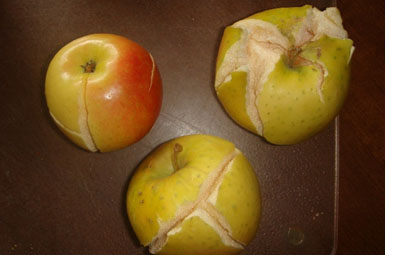 Much of the St Louis Metro-east is anywhere from abnormally dry to suffering a moderate drought. Apple harvest has finished for Jonathan and finishing up Golden Delicious and Red Delicious. Harvest of Fuji, Braeburn and Cameo is just getting started. Rain at this stage could be both a blessing and a curse. Some apple cultivars like Fuji are susceptible to cracking. Absorption of rain water through the skin, combined with the uptake of water from the roots, results in rapid enlargement of cells within the fruit. The internal pressure from the enlarged cells of the fruits creates a strain that cracks the skin. The most severe cracking often occurs when heavy rains follow a period of drought. Fruit most likely to crack include those developing on the periphery of the tree canopy, those with high sugar concentrations, and those with skin russet. So far quality has been excellent so let's hope that Mother Nature delivers much needed rain in a gentle enough manner to not cause fruit cracking.
Much of the St Louis Metro-east is anywhere from abnormally dry to suffering a moderate drought. Apple harvest has finished for Jonathan and finishing up Golden Delicious and Red Delicious. Harvest of Fuji, Braeburn and Cameo is just getting started. Rain at this stage could be both a blessing and a curse. Some apple cultivars like Fuji are susceptible to cracking. Absorption of rain water through the skin, combined with the uptake of water from the roots, results in rapid enlargement of cells within the fruit. The internal pressure from the enlarged cells of the fruits creates a strain that cracks the skin. The most severe cracking often occurs when heavy rains follow a period of drought. Fruit most likely to crack include those developing on the periphery of the tree canopy, those with high sugar concentrations, and those with skin russet. So far quality has been excellent so let's hope that Mother Nature delivers much needed rain in a gentle enough manner to not cause fruit cracking.
 Some weather effects don't show up until the next year. Take for instance peaches. Sustained periods of high temperature during the flower bud initiation phase (beginning late June to late July) can cause the production of 1, 2, or 3 pistils. If pollinated, this may cause single, double or triple fruit the following spring. These doubles and triples are fused together and need to be thinned off because the resultant fruit are unmarketable. Sometimes with doubles, one fruit may abort and the resultant peach will have a malformed suture at harvest which makes it also unmarketable.
Some weather effects don't show up until the next year. Take for instance peaches. Sustained periods of high temperature during the flower bud initiation phase (beginning late June to late July) can cause the production of 1, 2, or 3 pistils. If pollinated, this may cause single, double or triple fruit the following spring. These doubles and triples are fused together and need to be thinned off because the resultant fruit are unmarketable. Sometimes with doubles, one fruit may abort and the resultant peach will have a malformed suture at harvest which makes it also unmarketable.
Plasticulture strawberry plants are growing and putting on runners, which at some point in the near future will require removal. Grapes have been pretty well harvested, though some may still have Norton to finish up. Post-harvest disease control, specifically downy mildew and powdery mildew, is critical in grapes. In some years, these diseases may cause defoliation well before the onset of cool weather in the fall. Post-harvest defoliation predisposes the vines to winter injury and reduces productivity for the following season. Continue to follow disease management recommendations in the 2017 Midwest Fruit Pest Management Guide https://ag.purdue.edu/hla/Hort/Documents/ID-465.pdf. This is peak pumpkin season and the coming weekend will be the busiest for farmers markets, farm stands and u-picks. In addition to the traditional Jack-o-lantern, demand for "specialty" pumpkins continues, including anything with a unique color, pattern, shape or texture. Quality and abundance is high. In addition to pumpkin harvest, tomatoes and peppers are still in harvest.
Elizabeth Wahle (618-344-4230; wahle@illinois.edu)
From north central Illinois...
Dry conditions throughout much of August and September have helped and hindered growers. With little rain for the past two months, seed germination of fall crops was poor in non-irrigated fields. I have been dragging the hose around supplementing for beds of seeded spinach, carrots, and cover crops. The lack of rain and significant time spent holding a hose watering plants prompted some changes to my irrigation system. While drip tape works well for transplants, it does not give the best coverage for direct densely seeded crops. I have been experimenting with different types of drip emitters (drip tape, drip tube, and micro sprays). The type of irrigation depends on the crops. Drip tape and drip tube work great on plants with a larger footprint, i.e., tomatoes, peppers, potatoes. On the other hand, micro sprays deliver a wider pattern of irrigation that is more conducive to smaller crops such as carrots or turnips. Most of my beds continue to be irrigated with drip tape, but I am going to be transitioning some beds to micro-sprays next year to see how that better fits my growing methods.

Micro spray emitter along mid rib of high tunnel watering center bed. Photo by C. Enroth.
Driving around west-central Illinois, lack of rainfall patterns become apparent. The Quincy area seems exceptionally dry. I visited a garden there last week, and if the plants were not irrigated, they were under drought stress. Growers harvesting dried beans have enjoyed the weather as it allowed plants to dry down and gave a good window for picking. Rain is in the forecast. It looks like a good long fall rain event. I think most are welcoming a couple of days of rain.
In our local donation garden in Macomb, carrots are putting on decent growth as we hope to hold those through to January. Spinach is germinating outside, but in the high tunnel, it has been too hot, and I could not keep up with the irrigation needs of the germinating seed. I think the seed germinated, while I was traveling for work and the seedlings dried up. Transplanted romaine lettuce, Swiss chard, bok choi, and broccoli are all performing very well both in the field and in the high tunnel.
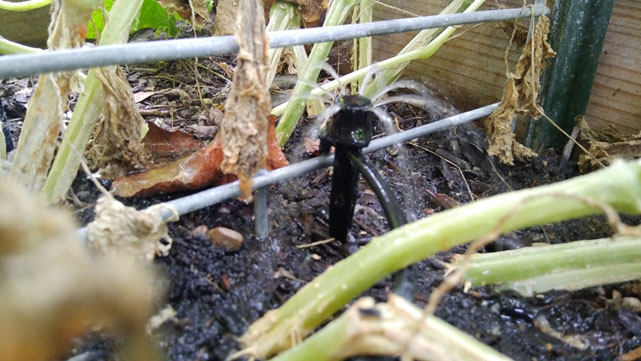
Micro spray emitter in cucumber bed in high tunnel. Photo by C. Enroth.
Last month the Cascade hops were harvested, dried, vacuum-sealed, and packed away in the freezer. A batch already made its way into a Master Gardeners homebrew. I look forward to the results! I put together three videos on my hops harvest this year. 1) Building a drying rack, 2) determining when hops should be harvested, and 3) harvesting hops.
From east central Illinois...
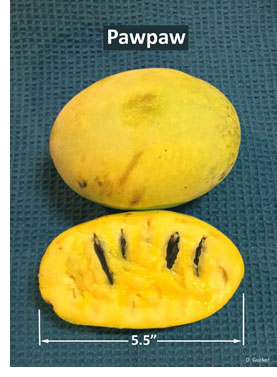 It has been a very dry month so far. In talking with a couple of CSA owners, they stated that unlike in the past, their CSA's would not be operating past the end of subscriptions due to lack of soil moisture and low water levels in wells. In addition, those with fall crops have commented on experiencing increased insect pressure, which is probably another side effect of the current drought conditions.
It has been a very dry month so far. In talking with a couple of CSA owners, they stated that unlike in the past, their CSA's would not be operating past the end of subscriptions due to lack of soil moisture and low water levels in wells. In addition, those with fall crops have commented on experiencing increased insect pressure, which is probably another side effect of the current drought conditions.
Pawpaw harvest is about done with fruit quality good but small size as you can see. If you have never tasted a pawpaw you are missing out on one of America's best kept secrets. It is the largest tree fruit native to the United States. Ripe fruit has a "tropical" scent with sweet, creamy textured flesh that tastes similar to banana with hints of peach and citrus.
Doug Gucker (217-877-6042; dgucker@illinois.edu)
From southern Illinois...
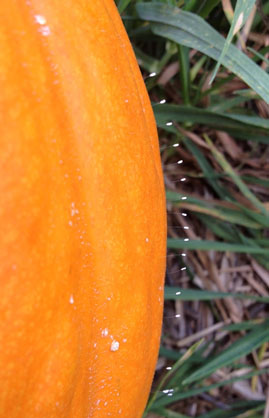
Green lacewing eggs on pumpkin fruit
in southern Illinois. Photo by N. Johanning.
At the moment we are still rather dry and except for a surprise spotty showers on Tuesday we haven't gotten any notable amount of rain since the last newsletter...and before. Even then IF you did catch a shower it may have been 0.4" like we had in Ewing (Franklin Co.), but many areas did not see a drop. It has been fairly humid with temperature in the 80s and we are supposed to stay fairly warm with supposedly better chances of rain over the weekend into the first of next week and highs back in the 70s.
While it has been nice not having to deal with pumpkin harvest in the mud, it is VERY dry and we desperately need rain. Fall crops have really been struggling, especially later plantings without irrigation. Surprisingly, pumpkins have been doing very well despite the dry. I have gotten a pretty good second set on most that are starting to ripen and the dry does not seem to be affecting fruit size as much as I would expect. Aphids are a significant issue for many growers on pumpkins (see the article later article for more on aphids in pumpkins). On the opposing side of the insect world, I saw green lacewing eggs laid on pumpkin fruit. Green lacewing is a beneficial predator of aphids and many other soft bodied insects so maybe Mother Nature will come full circle and clean up my aphid issues! Apple harvest still continues and quality is still very good overall. Hopefully, we will catch some rain before I write the next newsletter article
Nathan Johanning (618-939-3434; njohann@illinois.edu)
Fruit and Vegetable Production and Pest Management
Aphids on Pumpkins
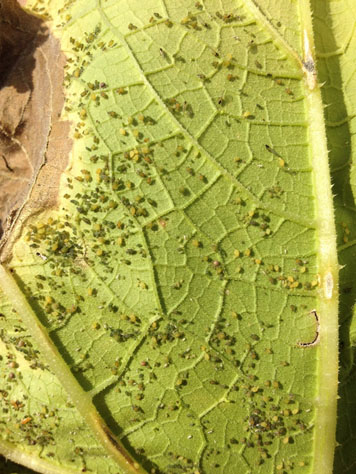
Aphid infestation on the underside of a pumpkin leaf
in southern Illinois. Photo by N. Johanning.
With the dry weather also has come aphid issues on pumpkins this season. Do you have aphids in your pumpkin fields? You might notice this first as some fruit that look unusually shiny, but upon further inspection you will see something like the picture to the right which is a heavy infestation of aphids on the underside of a pumpkin leaf. Aphids might not be widespread, but in this case localized on specific leaves throughout the field. At this point in the season the aphids generally do not cause a great deal of damage to the plant itself as most of its most vigorous growing is done; however, the excrement (honeydew) produced by the aphids can cover pumpkin fruit and from there black sooty mold will come in on that honeydew leaving a black film on the fruit. None of this is physically damaging to the fruit, but is not aesthetically pleasing so...you might end up washing affected fruit which depending on the scale of your operation and severity of aphids can be a major undertaking.
There are some management options and consult the 2017 Midwest Vegetable Production Guide for further information. Note that over spraying of many of our insecticides we use for cucumber beetle and squash bug control can also remove our aphid predators allowing populations to increase as well. One aphid specific product you might consider is Beleaf. It is listed in the guide but is very specific to aphids and is very effective. Whether or not to spray at this point is up to you and some things to consider would be how many fruit you have left out in the field. Another alternative would also be to try and harvest our as many of the fruit as possible before the sooty mold becomes an issue if aphids are just starting to show up.
Nathan Johanning (618-939-3434; njohann@illinois.edu)
Less Seriously...
https://www.bing.com/images/search?q=pest+management+humor&qpvt=pest+management+humor
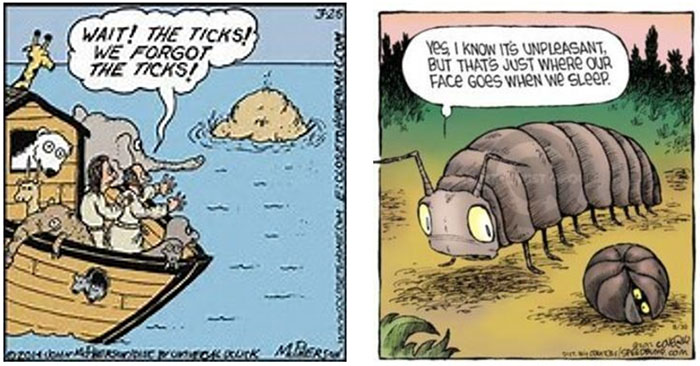
University of Illinois Extension Specialists in Fruit and Vegetable Production & Pest Management
Extension Educators – Local Food Systems and Small Farms |
||
Bronwyn Aly, Gallatin, Hamilton, Hardin, Pope, Saline, and White counties |
618-382-2662 |
|
Katie Bell, Franklin, Jackson, Perry, Randolph, & Williamson counties |
618-687-1727 |
|
Sarah Farley, Lake & McHenry counties |
847-223-8627 |
|
Nick Frillman, Woodford, Livingston, & McLean counties |
309-663-8306 |
|
Laurie George, Bond, Clinton, Jefferson, Marion, & Washington counties |
618-548-1446 |
|
Zachary Grant, Cook County | 708-679-6889 | |
Doug Gucker, DeWitt, Macon, and Piatt counties |
217-877-6042 |
|
Erin Harper, Champaign, Ford, Iroquois, and Vermillion counties |
217-333-7672 |
|
Grace Margherio, Jackie Joyner-Kersee Center, St. Clair County |
217-244-3547 |
|
Grant McCarty, Jo Daviess, Stephenson, and Winnebago counties |
815-235-4125 |
|
Katie Parker, Adams, Brown, Hancock, Pike and Schuyler counties |
217-223-8380 |
|
Kathryn Pereira, Cook County |
773-233-2900 |
|
James Theuri, Grundy, Kankakee, and Will counties |
815-933-8337 |
|
Extension Educators – Horticulture |
||
Chris Enroth, Henderson, Knox, McDonough, and Warren counties |
309-837-3939 |
|
Richard Hentschel, DuPage, Kane, and Kendall counties |
630-584-6166 |
|
Andrew Holsinger, Christian, Jersey, Macoupin, & Montgomery counties |
217-532-3941 |
|
Extension Educators - Commercial Agriculture |
||
Elizabeth Wahle, Fruit & Vegetable Production |
618-344-4230 |
|
Nathan Johanning, Madison, Monroe & St. Clair counties |
618-939-3434 |
|
Campus-based Extension Specialists |
||
Kacie Athey, Entomology |
217-244-9916 |
|
Mohammad Babadoost, Plant Pathology |
217-333-1523 |
|